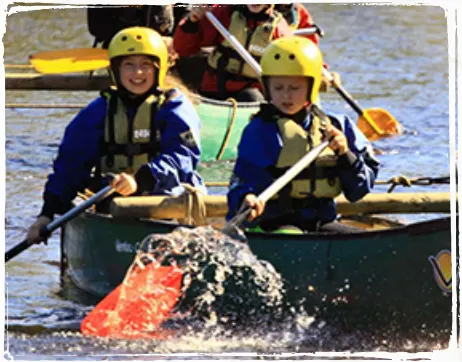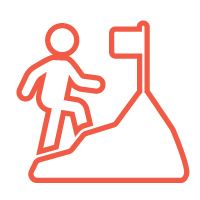Year Groups
- Primary School
- Secondary School
- Post 16

Duration
- Half Day
- Full Day
Difficulty
Adapted to the age and level of experience of students on adventure.
CURRICULUM LINKS
Key Stage 2: Geography, History
Key Stage 3: Design & Technology, History
Key Stage 4: PE, Geography
navigating waterways
Canoeing is a great way to get on the water and go for an adventure. On an easy-going journey on gentle waters, or one that is action packed and exciting, canoes are stable, versatile and offer a lot of fun along the way.
Students will learn the strokes, learn to read the water and, most importantly, learn to communicate with their canoeing buddy so they can control their canoe together.
Our canoeing adventures follow rivers in the Yorkshire Dales and North York Moors National Parks, and the time on the water is adapted to the age and level of experience of students on adventure.
What’s Included
Students are provided with the following equipment, as and when appropriate.

All specialist equipment
Canoe, paddles, watersports helmet, and buoyancy aid.
All specialist clothing
Waterproofs and wetsuits when required.
Transport
Once at the centre, all transport to and from adventure activities is provided.
Experienced, full-time, outdoor teachers and tutors
Each group of 12 students is led by a fully qualified and experienced outdoor tutor.
– back in the classroom –
curriculum links
Canoeing is an incredible way to get up close and personal with the water and engage with it in person. Curriculum can be met learning all about the craft, the environment you are canoeing in, or learning about local history, myths and legends.
Key Stage 2
Geography: Water Cycle
Students will see the water cycle in action. They can discuss how water moves around the world and ultimately ends up where they are. Other aspects can also be discussed such as where drinking water comes from and it is processed.
History
Students can learn all about the history of canoes – where they came from, what they were used for, and by who.
Key Stage 3
Design and Technology
Canoeists can learn all about the design of the canoe and how materials have developed over time. They can also learn how balance and trim effects the performance of the craft.
History: Local
Local history and the influence of the waterway can be explored in detail. Students can learn about what the areas close to the waterway were used for, now and in the past, and how this has changed over time.
Key Stage 4
PE
Following the GCSE P.E curriculum, we can develop student’s skills to help them perform core paddling skills/techniques in increasingly demanding and progressive drills in interesting and fun environments.
Geography
The challenge of natural hazards is part of the GCSE curriculum. Whilst canoeing, students can spend time talking about these hazards and how they have shaped our environment. The shape of river valleys for example, changes as the rivers flows downstream – there is no better way to explore this than from in a canoe.
LOCATIONS: Offered at both Bewerley Park and East Barnby
YEAR GROUPS: Suitable for Primary School, Secondary School, and post 16 students

DURATION: Available as a full or half day activity

DIFFICULTY: Adapted to the age and level of experience of students on adventure
CURRICULUM LINKS:
Key Stage 2: Geography, History
Key Stage 3: Design & Technology, History
Key Stage 4: PE, Geography
navigating waterways
Canoeing is a great way to get on the water and go for an adventure. On an easy-going journey on gentle waters, or one that is action packed and exciting, canoes are stable, versatile and offer a lot of fun along the way.
Students will learn the strokes, learn to read the water and, most importantly, learn to communicate with their canoeing buddy so they can control their canoe together.
Our canoeing adventures follow rivers in the Yorkshire Dales and North York Moors National Parks, and the time on the water is adapted to the age and level of experience of students on adventure.
What’s Included?
All specialist equipment
All sporting equipment and adventure specific helmets and harnesses.
All specialist clothing
Waterproofs, wellies and wetsuits, when required. Ideally students should bring their own wellies, but we have plenty on hand to lend.
Transport
Once at the centre, all transport to and from adventure activities is provided.
Experienced, full-time, outdoor teachers and tutors
Each group of 12 students is led by a fully qualified and experienced outdoor tutor.
classroom benefits
curriculum links
Canoeing is an incredible way to get up close and personal with the water and engage with it in person. Curriculum can be met learning all about the craft, the environment you are canoeing in, or learning about local history, myths and legends.
Key Stage 2
Geography: Water Cycle
Students will see the water cycle in action. They can discuss how water moves around the world and ultimately ends up where they are. Other aspects can also be discussed such as where drinking water comes from and it is processed.
History
Students can learn all about the history of canoes – where they came from, what they were used for, and by who.
Key Stage 3
Design and Technology
Canoeists can learn all about the design of the canoe and how materials have developed over time. They can also learn how balance and trim effects the performance of the craft.
History: Local
Local history and the influence of the waterway can be explored in detail. Students can learn about what the areas close to the waterway were used for, now and in the past, and how this has changed over time.
Key Stage 4
P.E.
Following the GCSE P.E curriculum, we can develop student’s skills to help them perform core paddling skills/techniques in increasingly demanding and progressive drills in interesting and fun environments.
Geography
The challenge of natural hazards is part of the GCSE curriculum. Whilst canoeing, students can spend time talking about these hazards and how they have shaped our environment. The shape of river valleys for example, changes as the rivers flows downstream – there is no better way to explore this than from in a canoe.